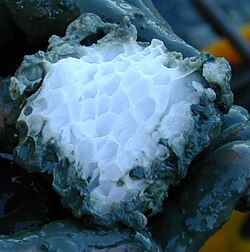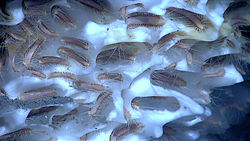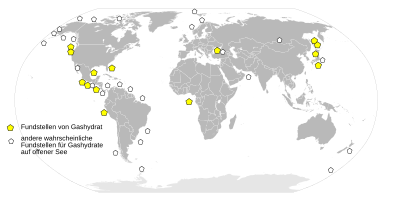Mögliche Methanquellen und -senken
A molecule of methane consists of one atom of carbon and four atoms of hydrogen. Methane can be generated by microbes and can also be generated by processes that do not require life, such as reactions between water and olivine (or pyroxene) rock. Ultraviolet radiation (UV) can induce reactions that generate methane from other organic chemicals produced by either biological or non-biological processes, such as comet dust falling on Mars. Methane generated underground in the distant or recent past might be stored within lattice-structured methane hydrates called clathrates, and released by the clathrates at a later time, so that methane being released to the atmosphere today might have formed in the past.
Winds on Mars can quickly distribute methane coming from any individual source, reducing localized concentration of methane. Methane can be removed from the atmosphere by sunlight-induced reactions (photochemistry). These reactions can oxidize the methane, through intermediary chemicals such as formaldehyde and methanol, into carbon dioxide, the predominant ingredient in Mars' atmosphere.Relevante Bilder
Relevante Artikel
MethanhydratMethanhydrat, auch Methanclathrat oder Clathrathydrat, Methaneis oder brennbares Eis genannt, ist eine natürlich vorkommende, eisartige Substanz. Es ist aus Wassermolekülen aufgebaut, die über Wasserstoffbrückenbindungen eine Käfigstruktur bilden, in der Methanmoleküle eingeschlossen sind. Das eingeschlossene Methan stammt vorwiegend aus der mikrobiellen Methanogenese und zum Teil aus geologischen Prozessen. Als eine hochkonzentrierte Form von Methan, die große Mengen Kohlenstoff bindet, ist Methanhydrat eine bedeutende Komponente des globalen Kohlenstoffzyklus. .. weiterlesen




























